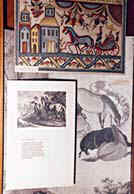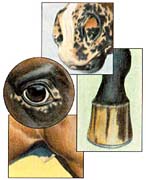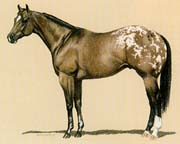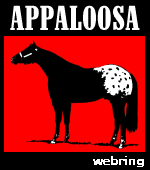|
| |
History
and Origin of the Breed
The Appaloosa’s colorful ancestry can be traced back to the earliest
recorded time, but it is in the American melting pot that the spotted horse
established itself as a true breed. The Nez  Perce
Indians of the inland Northwest deserve much of the credit for the Appaloosa
horses we have today. As the only Native Americans known to selectively breed
their horses, the Nez Perce desired only the strongest, fastest and most
sure-footed of mounts. The influx of white settlers to the Northwest changed the
Nez Perce’s destiny and nearly destroyed the legacy of their horse-breeding
efforts. War ensued when some of the Nez Perce rebelled against imposed
treaties. Over several months and over 1,300 miles, the Appaloosa helped the
non-treaty Nez Perce elude the U.S. Cavalry in 1877. At the time of Chief
Joseph’s surrender in Montana, the Army confiscated most of their horses,
including Appaloosas. The prized characteristics of the distinctive horse then
became lost or severely diluted due to indiscriminate breeding. Perce
Indians of the inland Northwest deserve much of the credit for the Appaloosa
horses we have today. As the only Native Americans known to selectively breed
their horses, the Nez Perce desired only the strongest, fastest and most
sure-footed of mounts. The influx of white settlers to the Northwest changed the
Nez Perce’s destiny and nearly destroyed the legacy of their horse-breeding
efforts. War ensued when some of the Nez Perce rebelled against imposed
treaties. Over several months and over 1,300 miles, the Appaloosa helped the
non-treaty Nez Perce elude the U.S. Cavalry in 1877. At the time of Chief
Joseph’s surrender in Montana, the Army confiscated most of their horses,
including Appaloosas. The prized characteristics of the distinctive horse then
became lost or severely diluted due to indiscriminate breeding.
Claude Thompson, a wheat farmer from Moro, Oregon, realized the importance of
preserving the spotted horse breed and in 1938, he established the Appaloosa
Horse Club to promote and restore the Appaloosa’s position in the equine  world.
The Appaloosa began its return from the brink of obscurity. While the Nez Perce
never called their spotted horses "Appaloosas," the breed’s name
comes from either the Palouse River, which flows through the region of eastern
Washington and north Idaho where the horses were known to be plentiful or from
the Palouse Tribe, whose main village was situated on the Palouse River. White
settlers first described the colorful native mounts as "a Palouse
horse," which was soon slurred to "Appalousey." The name
"Appaloosa" was officially adopted in 1938. Today, over a half million
Appaloosas are registered with the Appaloosa Horse Club. world.
The Appaloosa began its return from the brink of obscurity. While the Nez Perce
never called their spotted horses "Appaloosas," the breed’s name
comes from either the Palouse River, which flows through the region of eastern
Washington and north Idaho where the horses were known to be plentiful or from
the Palouse Tribe, whose main village was situated on the Palouse River. White
settlers first described the colorful native mounts as "a Palouse
horse," which was soon slurred to "Appalousey." The name
"Appaloosa" was officially adopted in 1938. Today, over a half million
Appaloosas are registered with the Appaloosa Horse Club.
Breed
Characteristics
Although Appaloosas are most commonly recognized by their colorful coat
patterns, they also have other distinctive characteristics. The four  identifiable
characteristics are: coat patterns, mottled skin, white sclera, and striped
hooves. The Appaloosa Horse Club recognizes thirteen base coat colors. It is not
always easy to predict the color a grown horse will be from the shade it has as
a foal. Most foals are born with lighter colored coats than they will have when
they shed their baby hair with the exception of gray horses, which are born dark
and progressively become lighter. A remarkable aspect of the Appaloosa is the
myriad of color and pattern combinations they can exhibit. The seven common
terms used to describe Appaloosa coat patterns are blanket, spots, blanket with
spots, roan, roan blanket, roan blanket with spots, and solid. Appaloosa
patterns are highly variable and there are many which may not fit into specific
categories easily. identifiable
characteristics are: coat patterns, mottled skin, white sclera, and striped
hooves. The Appaloosa Horse Club recognizes thirteen base coat colors. It is not
always easy to predict the color a grown horse will be from the shade it has as
a foal. Most foals are born with lighter colored coats than they will have when
they shed their baby hair with the exception of gray horses, which are born dark
and progressively become lighter. A remarkable aspect of the Appaloosa is the
myriad of color and pattern combinations they can exhibit. The seven common
terms used to describe Appaloosa coat patterns are blanket, spots, blanket with
spots, roan, roan blanket, roan blanket with spots, and solid. Appaloosa
patterns are highly variable and there are many which may not fit into specific
categories easily.
Mottled or partli-colored skin is also an Appaloosa characteristic. Mottled
skin is different from commonly found pink (flesh-colored or non-pigmented) skin
in that it normally contains dark areas of pigmented skin within its area. The
result is a speckled or blotchy pattern of pigmented and non-pigmented skin.
The sclera is the white area of the eye, which covers the entire eyeball
except the cornea - the colored or pigmented portion. The white of the human eye is an example. All
horses have sclera but the Appaloosa’s is white and usually more readily
visible than other breeds. Readily visible white sclera is a distinctive
Appaloosa characteristic provided it is not in combination with a large white
face marking, such as a bald face.
colored or pigmented portion. The white of the human eye is an example. All
horses have sclera but the Appaloosa’s is white and usually more readily
visible than other breeds. Readily visible white sclera is a distinctive
Appaloosa characteristic provided it is not in combination with a large white
face marking, such as a bald face.
Many Appaloosas will have bold and clearly defined vertically light or dark
striped hooves. However, vertical stripes also may result from injury to the
coronet or found in association with a white marking on the leg. Also, light
colored horses tend to have thin stripes in their hooves. As a result, all
striped hooves do not necessarily distinguish Appaloosas from non-Appaloosas.
Member of:
 

Appaloosa Links
Forest
Edge Appaloosas

|

![]()